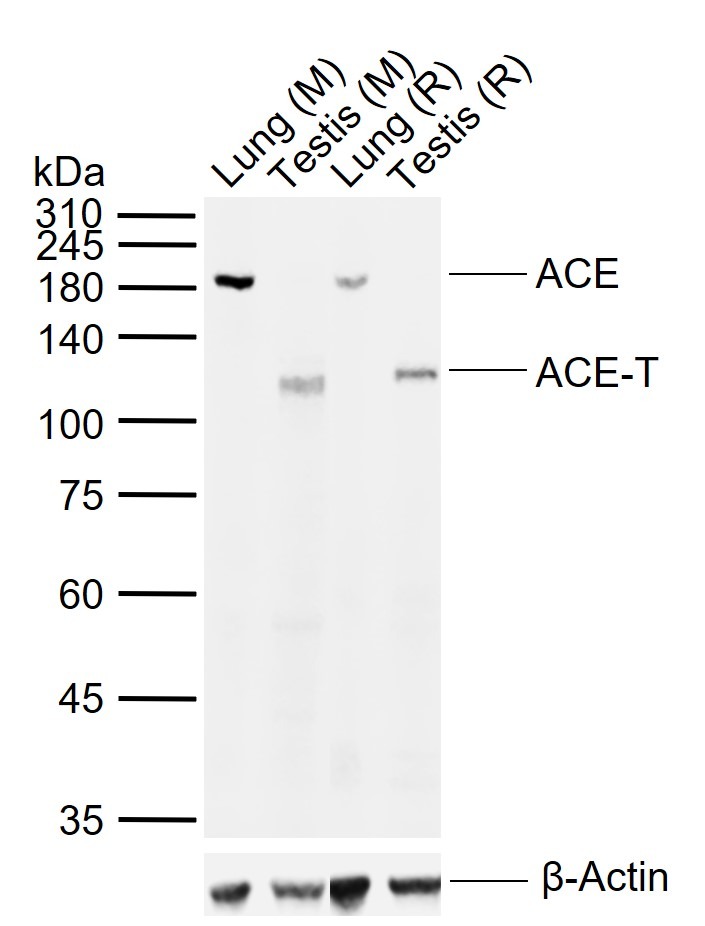Shopping Cart
Remove All Your shopping cart is currently empty
Your shopping cart is currently empty
Anti-ACE Polyclonal Antibody is a Rabbit antibody targeting ACE. Anti-ACE Polyclonal Antibody can be used in ELISA,WB.
| Pack Size | Price | USA Warehouse | Global Warehouse | Quantity |
|---|---|---|---|---|
| 50 μL | $220 | 7-10 days | 7-10 days | |
| 100 μL | $374 | 7-10 days | 7-10 days | |
| 200 μL | $529 | 7-10 days | 7-10 days |
| Description | Anti-ACE Polyclonal Antibody is a Rabbit antibody targeting ACE. Anti-ACE Polyclonal Antibody can be used in ELISA,WB. |
| Synonyms | Kininase II, EC 3.4.15.1, Dipeptidyl carboxypeptidase I, DCP DCP1, CD antigen CD143, Angiotensin-converting enzyme |
| Ig Type | IgG |
| Reactivity | Mouse,Rat (predicted:Human,Dog,Pig,Cow) |
| Verified Activity | Sample: Lane 1: Mouse Lung tissue lysates Lane 2: Mouse Testis tissue lysates Lane 3: Rat Lung tissue lysates Lane 4: Rat Testis tissue lysates Primary: Anti-ACE (TMAB-00031) at 1/1000 dilution Secondary: IRDye800CW Goat Anti-Rabbit IgG at 1/20000 dilution Predicted band size: 147 kDa Observed band size: 110,180 kDa  |
| Application | |
| Recommended Dose | WB: 1:500-2000; ELISA: 1:5000-10000 |
| Antibody Type | Polyclonal |
| Host Species | Rabbit |
| Subcellular Localization | Angiotensin-converting enzyme, soluble form: Secreted. Cell membrane; Single-pass type I membrane protein. |
| Tissue Specificity | Ubiquitously expressed, with highest levels in lung, kidney, heart, gastrointestinal system and prostate. Isoform Testis-specific is expressed in spermatocytes and adult testis. |
| Construction | Polyclonal Antibody |
| Purification | Protein A purified |
| Appearance | Liquid |
| Formulation | 0.01M TBS (pH7.4) with 1% BSA, 0.02% Proclin300 and 50% Glycerol. |
| Concentration | 1 mg/mL |
| Research Background | Angiotensin Converting enzyme is involved in catalyzing the conversion of angiotensin I into a physiologically active peptide angiotensin II. Angiotensin II is a potent vasopressor and aldosterone-stimulating peptide that controls blood pressure and fluid-electrolyte balance. This enzyme plays a key role in the renin-angiotensin system. ACE converts angiotensin I to angiotensin II by release of the terminal His-Leu, this results in an increase of the vasoconstrictor activity of angiotensin. Also able to inactivate bradykinin, a potent vasodilatator. ACE exists in two forms, a 170KD somatic form and a 90KD germinal form. The somatic form is expressed by endothelial cells (especially those of lung capillaries and arterioles), epithelial cells (especially in proximal renal tubules and small intestine), by some neuronal cells and variably by some macrophages and T lymphocytes. The germinal form is expressed by spermatozoa. |
| Immunogen | KLH conjugated synthetic peptide: human ACE1 |
| Antigen Species | Human |
| Gene Name | ACE |
| Gene ID | |
| Protein Name | Angiotensin-converting enzyme |
| Uniprot ID | |
| Biology Area | Response to hypoxia,Serum Proteins,Vasoconstriction,ACEs,Cardiovascular ELISA kits,Vitamins / minerals,Hypoxia,Vitamins / Minerals,Surface Molecules |
| Function | Converts angiotensin I to angiotensin II by release of the terminal His-Leu, this results in an increase of the vasoconstrictor activity of angiotensin. Also able to inactivate bradykinin, a potent vasodilator. Has also a glycosidase activity which releases GPI-anchored proteins from the membrane by cleaving the mannose linkage in the GPI moiety. |
| Molecular Weight | Theoretical: 147 kDa. |
| Stability & Storage | Store at -20°C or -80°C for 12 months. Avoid repeated freeze-thaw cycles. |
| Transport | Shipping with blue ice. |
| Size | Quantity | Unit Price | Amount | Operation |
|---|

Copyright © 2015-2025 TargetMol Chemicals Inc. All Rights Reserved.